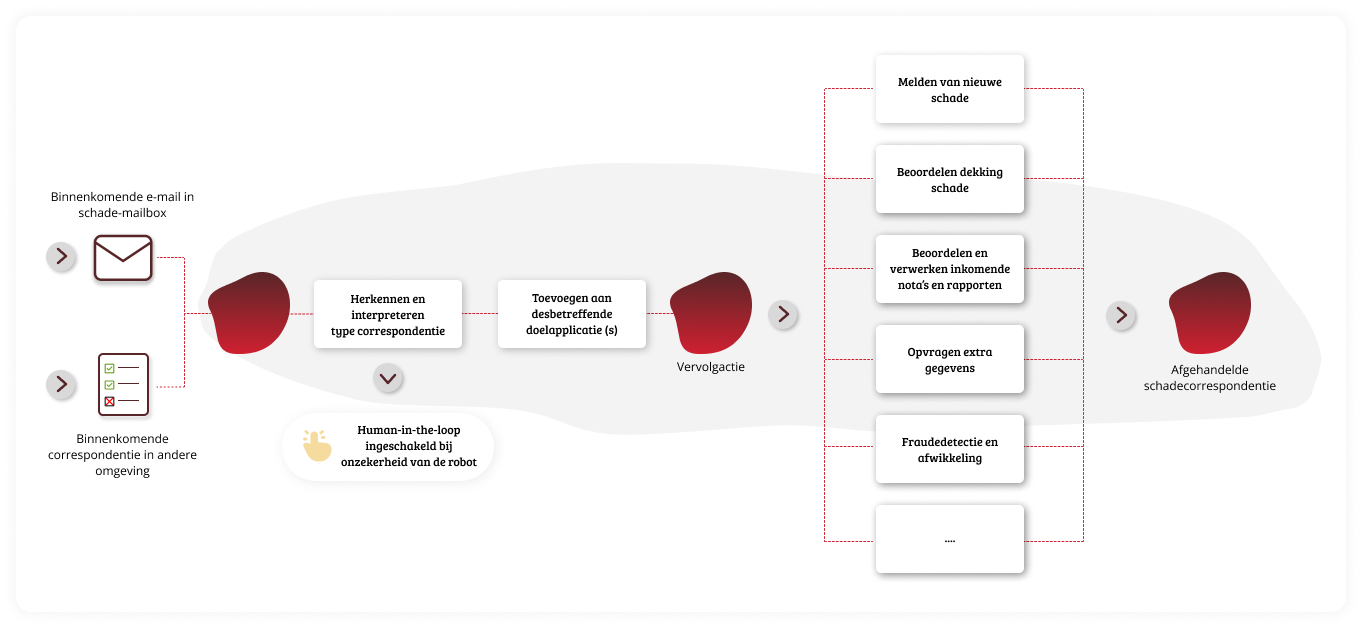How AI and RPA can handle incoming claims correspondence
Many insurers struggle with a structural overload of their shared claims mailboxes. Claims handlers spend a lot of time every day manually opening and reviewing incoming emails and attachments as well as processing this correspondence in the relevant target systems, such as CCS Level, ANVA or AS400. This leads not only to a high workload, but also to slower response times and higher operational costs. Several FTEs are often required to manage such a mailbox.
Department:
Claims
Type of emails
Claims, Notes and invoices, Expert reports, Counterparty correspondence
Results:
3000+ hours per year released
Lower workload during peak periods
Reason
At one of Tacstone Technology’s clients, 100,000 emails arrived in the shared claims mailbox annually. Consider:
- Handwritten damage assessment forms;
- Damage expert reports;
- Notes;
- Correspondence from counterparties;
- Police reports
- Etc.
It is crucial that these messages be recognized correctly and processed on the same day. Manual processing made this increasingly difficult to achieve.
Imagine a work situation where administrative e-mail processing is largely automated. Where peak periods no longer cause stress, and claims handlers can focus on customer contact, customized service and other substantive tasks for which they are trained.
In partnership with Tacstone Technology, organizations are now deploying a combination of AI and RPA to automatically “recognize” incoming emails including attachments and then process them in the underlying target systems. In this case study, learn how these technologies have been applied and the results – from cost savings to shorter turnaround times and higher employee satisfaction.
Approach
A mailbox contains diverse, unstructured information. Each email has a different intent and can have different follow-up steps. Traditional RPA solutions do not cover this because they can only follow fixed rules, whereas RPA in combination AI interprets the content, chooses the right action and executes it.
How does it work?
- AI reads and interprets incoming emails and attachments To determine intent (e.g. new claim notification, additional question, etc.)
- AI extracts relevant customer and claims data retrieves from CRM and ERP systems
- AI determines what to do with the email and attachments and RPA performs the relevant action
- RPA escalates only in complex or exceptional cases To a human collaborator
The process

AI versus traditional, rule-based systems?
Processing emails and documents with AI offers significant advantages over traditional rule-based systems, primarily in terms of accuracy and flexibility.
Whereas a rule-based system relies on predefined keywords and fixed workflows, AI can use Natural Language Processing (NLP) and Machine Learning to better understand the content and intent of an email. This allows for more diverse and accurate categorization.
Another key benefit of AI is the automatic extraction of relevant data. Instead of relying on preset fields, AI can recognize and process unstructured information, such as customer data or claims, regardless of how it is presented in the email. This results not only in faster processing, but also in less human intervention and robot downtime.
Wondering what email automation will benefit your organization?
Schedule a short Teams appointment to explore together the possibilities of email automation for your organization. We will immediately make a simple business case and outline a plan to get you started with smart automation.
Schedule an appointment now with Ilias Bouhannouche or Janpieter Koning – the first step to less manual work and more control over your insurance business.
